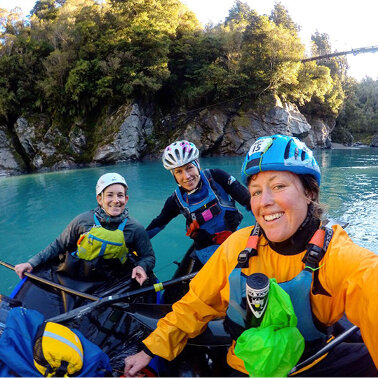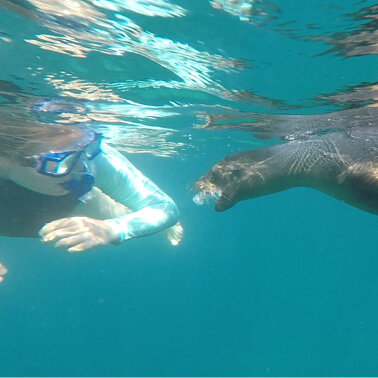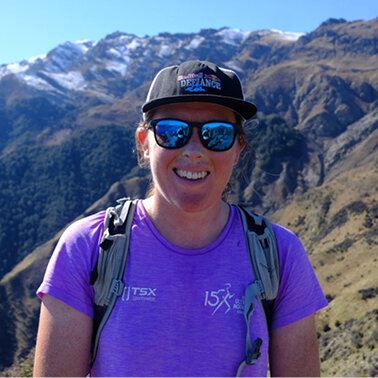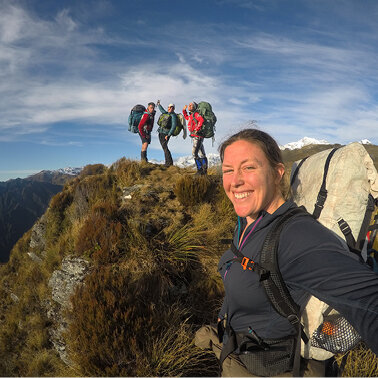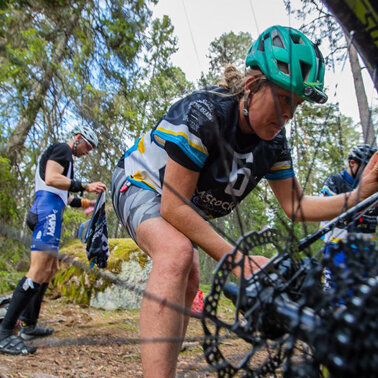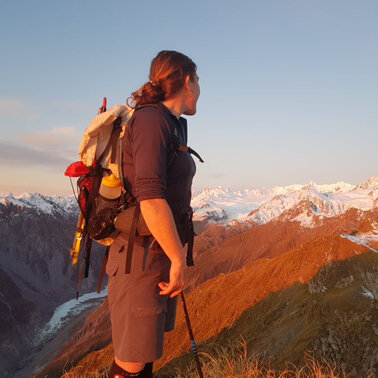Seizing the day
Multisports athlete Emily Wilson was 22 when she found out she had type 1 diabetes. Six years later, she reflects on how it changed her life for the better.
During my school years, I was a competitive swimmer, then I got drawn to triathlon. But it was competing in the Hillary Challenge – a five-day national secondary schools event near Tongariro – that was the biggest revelation.
It involves teams of eight competing in a series of physical and mental problem-solving challenges, then a two-day rogaine around the mountains, and the final day is a head-to-head adventure race, usually involving running, biking, kayaking, rafting, and rope skills.
This experience opened my mind to the possibilities and thrill of exploring the unknown, both physically and mentally. It was such a buzz to be part of a team, working together towards a common goal and especially to be off-road, paving our own way, learning heaps of new skills.
I felt so alive out there. It’s hard to explain or find the adjectives, but it was an intense feeling of knowing that this was where I was supposed to be.
I’d always been a very active and outdoors-orientated kid, but now I was just so inspired to keep adventuring and upskilling in all these outdoor pursuits because they gave me such joy and freedom.
After I left school, I studied physiology and sports science at university and kept adventuring.
A few years later, I was working in Canada as a Canoe Trip Leader for a summer camp in Northern Ontario, and I got three infections in a short space of time – strep throat, an infected nail, and a big abscess on my back.
The infection on my back – you could lose half your finger into it! It had to be packed from the inside out for weeks afterwards.
After the camp, I flew to South-East Asia and Nepal, and I had to get random people on the plane to dress it for me as I couldn’t reach easily – yuck. Then I had stomach issues during my next six weeks in Asia, probably from the strong antibiotics they made me take to avoid further infection. I’d also had giardia earlier in the same trip during an adventure race in South Africa, so on my return to New Zealand I thought I better get a check up.
DIFFICULT DIAGNOSIS
My GP Fiona was onto it. She said, “Emily, you hardly ever get sick, so it’s odd for you to have had all these infections. Let’s give you a blood test.” Sure enough, after a glucose test, my sugars were really high.
They sent me to hospital for the night, which was a bit weird as I felt fine, and they diagnosed me with diabetes. I actually didn’t have the antibodies they check for, but the endocrinologist was convinced it was type 1. Because of my sporting activity, my insulin sensitivity is really good. I also have type 1 on both sides of the family. They did also test me for the rare type – MODY – but the results came back negative.
I think I’d had it for years, undiagnosed. I’d always been thirsty a lot, especially over night, and I was emotional a lot too. I’ve also had issues with periods (and having done my thesis in physiology – in particular, female physiology in relation to exercise – I have some of my own theories!)
Initially, I was gutted. I remember crying into the mirror the first time I injected myself, knowing that this would be my daily reality. However, life is all about attitude. If you set your mind to something and you work hard, the outcomes are usually pretty good. Being stubborn, persistent, and diligent are good traits to have.
A doctor at the hospital told me, “Oh, you’ll have to really modify what you do. You probably won’t be able to compete like you used to, and you’ll have to create lots of routine.”
I had a strong grasp of the disease from studying it and a great understanding of my own body. Right there and then, I thought, “Heck no. I’m not adapting my life for diabetes – it’s coming along for the ride.”
MANAGING DIABETES WITH SPORTS
Growing up, I’d never had much patience, but this disease soon taught me about that! I learned the hard way, thrashing my body and getting injured.
I know now that if I listen to my body and invest time in testing regularly, eating well, stressing less, and exercising often, I can do anything. Stress is the biggest one and the hardest one for me to reduce, but it has a profound effect on my diabetes so I keep trying.
After some months of recording everything I did and ate, and trying to figure out patterns (quite hard when no two days are the same), I just threw myself back into sports and resigned myself to figuring it out as I went, because it’s a pretty fickle, unpredictable disease at the best of times.
I trialled different foods and different ways of injecting. For example, I tried increasing basal and reducing rapid-acting insulin, or injecting more on the start line to combat the inevitable adrenaline spike.
After much trial and error – and drowning in technology – I basically figured I just need to under-bolus. There’s no way we can go low if we don’t inject insulin, so I’m always on the cautious side and under-inject – or don’t inject at all sometimes. Yes, I might be high while exercising, with the dump in glucose from the liver also, but in the long run I know that’s not going to kill me.
I want to enjoy my time out there. I don’t micromanage my levels when exercising or racing, which can be hard when you’re eating little and often, but I don’t want to have to be adjusting all the time, because it increases the risk of lows and it detracts from my experience.
When you’re at the pointy end of competition, you can’t waste precious seconds stopping to check your blood-glucose levels. And when it’s cold or wet, the technology often doesn’t work.
The introduction of the Freestyle Libre has made things much easier, and it’s a great racing and training tool.
It’s still always a challenge to know how much insulin to inject at any one time when adventure racing. After all, you never know how long a leg is going to take you and whether you might run out of food, or have to climb an extra hill, or get cold and wet from the weather turning. And, of course, the sleep deprivation wreaks havoc with your hormones, and they’re intrinsically linked to blood-glucose levels.
I still prefer taking my pens into the outdoors, rather than using a pump. That’s because when I’m surfing, diving, climbing, bushbashing, hiking, paddling, and biking it’s too easy to rip it off my body. No thanks!
WORKING FOR THE DIABETES COMMUNITY
As soon as I was diagnosed, I decided to get involved with the community. I had a lot of ideas for ways to inspire people living with type 1 – especially young people.
In 2017, I did a self-powered adventure the full length of the country with Jerry the Bear, and I organised a series of teddy bears’ picnics along the way with Diabetes NZ branches. I started in Cape Reinga and paddled, pack-rafted, paddle boarded, road-biked, and mountain-biked my way down the country. I reached Bluff in about five weeks, completing the journey during Diabetes Awareness Month in November 2017.
I became the International Diabetes Federation (IDF) young leader for New Zealand in 2015 and went to the IDF Congress in Vancouver at the end of 2015. I had the position for two years from then.
All my jobs these days are community based, and I’ve always got great joy out of helping, teaching, and being around people, especially empowering the young people I work with to live their best lives.
I get a buzz out of being a part of something bigger than myself. I guess it’s in my nature to care, and although I often think, “What is it that I can give, and am I doing enough?” I’ve found that even just through leading by example and living your values, you can have a powerful impact on those around you – even if it seems subtle at first.
LIFE-BALANCE SECRETS
I’ve always been driven. My twin brother and my younger sister are the same. I have high standards for myself and an innate drive to be better at everything. Our parents never pushed us to do anything as they knew we were all already highly strung, high-achievers. They only ever gave us opportunities and endless support. Mum knew we put enough pressure on ourselves!
Although this drive might sound desirable, I definitely didn’t have a healthy balance for a long while, and I’ve had my fair share of injuries, unhealthy relationships with food, and times of extreme stress at university (all self-inflicted).
I think my type 1 diagnosis was my body’s way of forcing me to listen. I’ve had to learn to manage my expectations, chunk time up, and funnel my energy into one or two things at a time so I don’t get so overwhelmed by the possibilities. I’ve definitely got better at managing stress and letting go of the insignificant things. I’ve become much more relaxed, resourceful, adaptable, resilient, and happier within myself – and I have diabetes to thank for a lot of that.
I’m also lucky that, through my jobs, my sport, and all my activities in the community, I get to meet and connect with amazing people every day. I’m inspired by them: inspired to be better, for others and myself, and especially the environment. In 2017, I volunteered for conservation groups working with North Thailand’s elephants. I've also worked and volunteered on marine conservation projects in Costa Rica in 2018, and the Galápagos Islands in 2019. As well as this, I volunteer and work for DOC doing conservation and biodiversity work in remote Fiordland.
The outdoors, and training for multisport and adventure races, have definitely made me a better person and allowed me to contribute more to this world. What keeps me hooked on multisports and adventuring is the variety, along with the challenge, the unknown, and therefore the resilience, adaptability, and perseverance you must find within yourself. I’m a really curious person who loves to learn. What you learn about yourself, new places, and other people and how to get the best out of them is invaluable. There’s also the freedom, the joy, the thrill, and the feeling of truly living your passion.
There are endless opportunities to grow and improve in every multisports discipline. Sometimes you make slow progress, just like in life, but it’s worth it.
Of course, it is not always about just “getting better” or “improving”. That can be exhausting and sometimes unrealistic. However, these activities can be a form of meditation: a time to think about nothing, only the very next step, and to be totally present and aware. It’s a destressor and distractor from a busy mind and an ever increasing to-do list.
For me, my activities are a lifestyle, much more than a goal.
Each person’s diabetes is so different, and each person’s journey is so different. But there is no doubt that investing in yourself is the best start.
EMILY’S LATEST ACHIEVEMENTS
Team events: 4th women’s team, 2019 Redbull Defiance, Wanaka 1st team, 2019 Godzone Adventure Race 3rd team, 2019 World Series Adventure Race, Ecuador 1st team, 2019 Spring Challenge, Cromwell
Individual events: 1st, 2019 Peak to Peak Multisport Race, Queenstown 2nd, 2019 Rasdex River Race, Waimakariri 5th, 2020 Kathmandu Coast to Coast Longest Day
What’s next? Emily says, “I’m keen to do more backcountry skiing and boarding, making the most of a full winter in New Zealand. (I’m usually away for some of it overseas.) “I also want to take the chance while borders are closed to upskill in all my outdoor activities I enjoy. I definitely think there are a few more adventure races in me when money and travel allow.”


